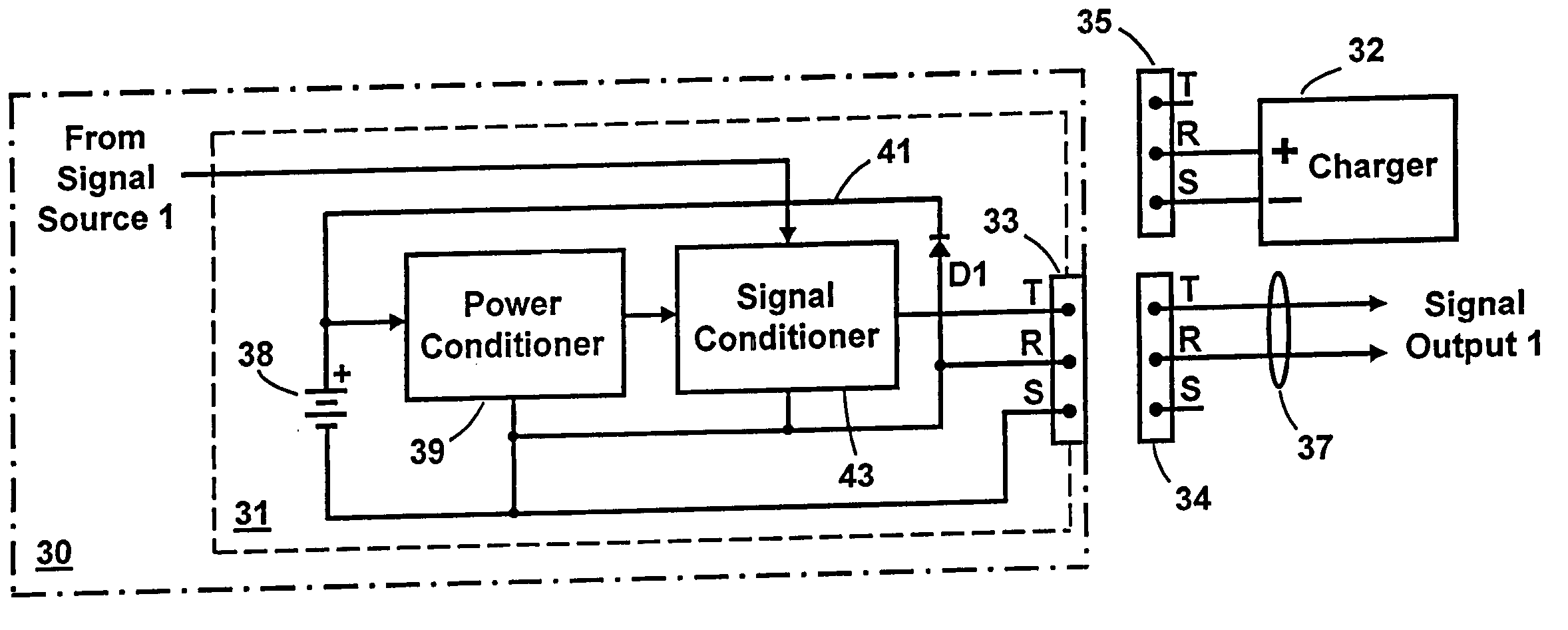Apparatus for powering an electronic musical instrument
a technology for electronic instruments and accessories, applied in the direction of electrophonic musical instruments, instruments, machines/engines, etc., can solve the problems of too often in a difficult to reach place in the instruments
- Summary
- Abstract
- Description
- Claims
- Application Information
AI Technical Summary
Benefits of technology
Problems solved by technology
Method used
Image
Examples
first embodiment
[0022] In FIG. 1 is shown a block diagram schematic of the invention wherein electronic circuitry including a signal conditioner 14 is located on a circuit board 11 on a musical instrument 10, but is powered by an electrical power source 20 that is external to the instrument. There is a jack 18 of the type described in the previous paragraph mounted on the musical instrument 10. There is also a plug 19 of the type described in the previous paragraph mounted on the end of a signal cable 21 that carries the conditioned signal to remote equipment such as an amplifier, soundboard or other audio equipment (not shown).
[0023] Briefly, the musical instrument 10 generates an electrical signal indicated as signal source 1 that is input to and processed by the signal conditioner 14 before being output from the instrument 10 via the jack 18. There is no source of electrical power mounted inside the instrument 10 for powering circuitry on the circuit board 11. The electronic circuitry mounted on...
third embodiment
[0034] In FIG. 4 is shown a block diagram schematic of the invention where a power source 32 external to an instrument 30 is used to provide power to circuitry on circuit board 31 inside musical instrument 30. More particularly, the external power source 32 is used to charge an energy storage device 38, preferably in the form of a capacitor or a rechargeable battery, located on the musical instrument 30. The electronic circuitry on the board 31 is in turn powered by the charged rechargeable power source 38. Thus, the prior art need to frequently get inside instrument 30 to replace a non-rechargeable battery is eliminated.
[0035] With this configuration a main difference is that external power from charger 32 is not applied to instrument 30 while a plug 34 on the end of a signal cable 37 is plugged into a jack 33 to output the conditioned audio signal from musical instrument 30.
[0036] More particularly, to charge the rechargeable battery 38 inside instrument 30 a charger 32 with a pl...
fourth embodiment
[0040] In FIG. 5 is shown a block diagram schematic of the invention where an electrical power source 32 external to instrument 30 is used to provide electrical power to circuitry on circuit board 31 inside musical instrument 30. More particularly, as previously described with reference to FIG. 4, external power source 32 is used to charge an electrical energy storage device 38 which is preferably a capacitor or a rechargeable battery 38 that is located on the musical instrument 30. The electronic circuitry on circuit board 31 is, in turn, powered by the rechargeable power source 38. Thus, the prior art need to frequently get inside the instrument to remove or replace the battery is eliminated.
[0041] There are many similarities between the third and fourth embodiments of the invention, but there are some key differences. One similarity is that both embodiments utilize a charger 32 with a plug 35. Another similarity is that power conditioner 39 is a DC-DC converter that is utilized i...
PUM
 Login to View More
Login to View More Abstract
Description
Claims
Application Information
 Login to View More
Login to View More - R&D
- Intellectual Property
- Life Sciences
- Materials
- Tech Scout
- Unparalleled Data Quality
- Higher Quality Content
- 60% Fewer Hallucinations
Browse by: Latest US Patents, China's latest patents, Technical Efficacy Thesaurus, Application Domain, Technology Topic, Popular Technical Reports.
© 2025 PatSnap. All rights reserved.Legal|Privacy policy|Modern Slavery Act Transparency Statement|Sitemap|About US| Contact US: help@patsnap.com



